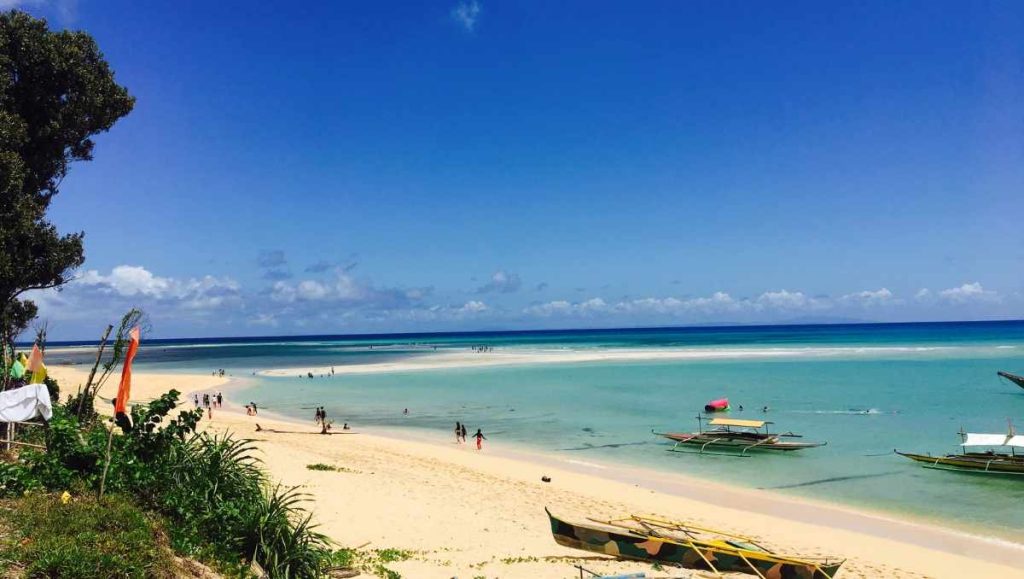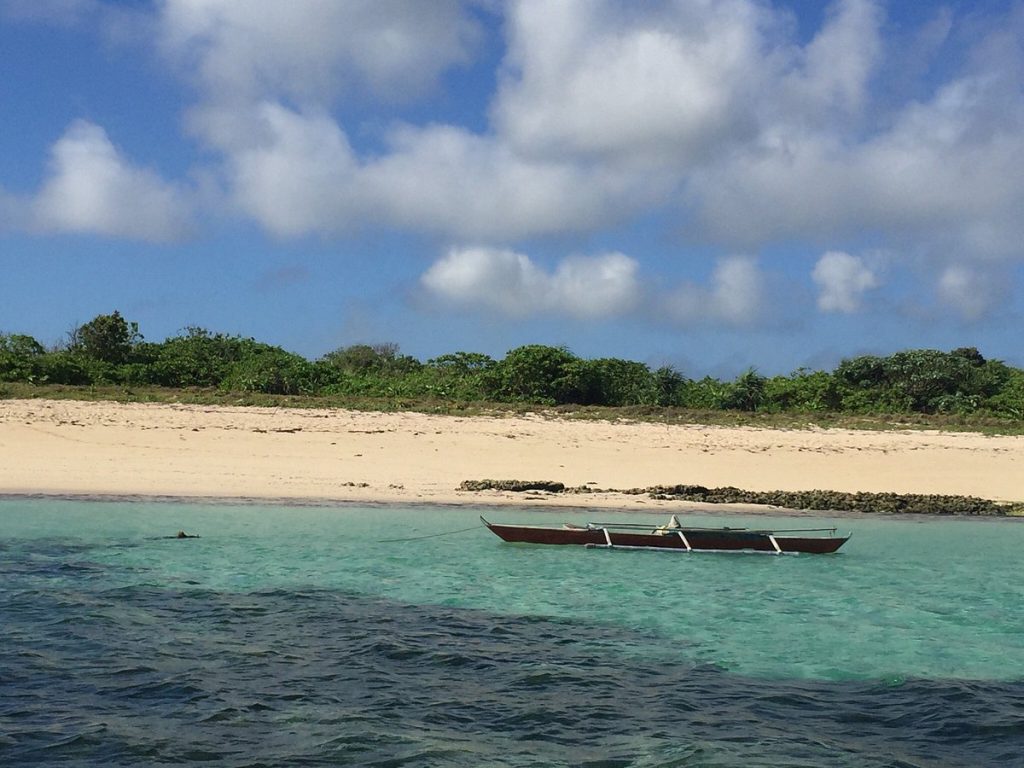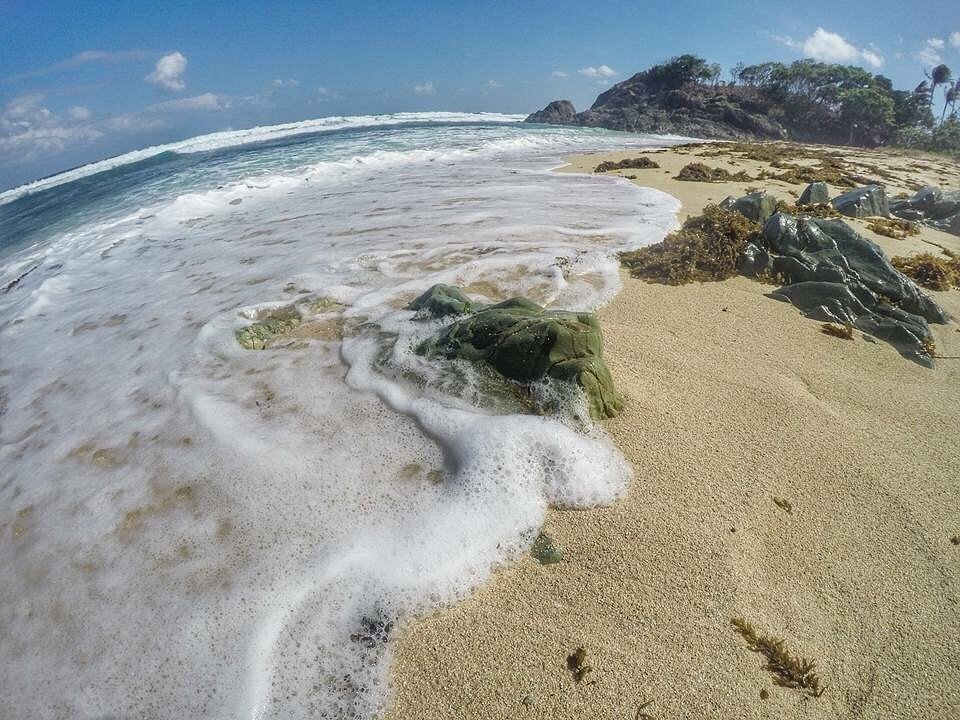Jomalig Island is a hidden gem located in the easternmost part of the Polillo Group of Islands in Quezon Province, Philippines.
It boasts stunning golden sand beaches, crystal-clear waters, and breathtaking landscapes that will leave you in awe. Despite its remote location, it has become a popular destination for travelers seeking an off-the-beaten-path adventure.
Getting to Jomalig Island is not the easiest task, but the journey is worth it. From Manila, tourists can take a bus or van to Real, Quezon, and then take a boat to Jomalig Island.
The travel time from Manila to Jomalig Island can take around 8 to 10 hours, but the scenic views along the way will make the trip worthwhile.
Once you arrive on the island, you’ll be greeted by friendly locals who are more than happy to share their culture and way of life with visitors.
There are several accommodations available on the island, ranging from budget-friendly homestays to more luxurious resorts.
Whether you’re looking for a relaxing beach vacation or an adventure-packed trip, Jomalig Island has something to offer for everyone.

Key Takeaways
- Jomalig Island is a remote yet stunning destination in Quezon Province, Philippines.
- Getting to the island requires a bit of effort, but the journey is worth it.
- The island offers a range of accommodations and activities for travelers seeking a unique and off-the-beaten-path adventure.
Getting to Jomalig Island
If you’re planning a trip to Jomalig Island, there are two main ways to get there: by air or by land and sea. Here’s what you need to know about each option.
By Air
Unfortunately, Jomalig Island does not have an airport. The nearest airport is in Manila, which is about 200 kilometers away. From there, you can take a bus or a private car to Real, Quezon, where you can catch a boat to Jomalig Island.
By Land and Sea
The most common way to get to Jomalig Island is by land and sea. You can take a bus or a private car from Manila to Real, Quezon, which is about a 4-5 hour drive. From there, you can catch a boat to Jomalig Island.
Several bus companies offer trips to Real, Quezon, including Raymond Bus and DLTB Co. The bus fare is around PHP 200-300, depending on the type of bus and the time of day.
Once you arrive in Real, Quezon, you can take a boat to Jomalig Island. The boat ride takes around 4-5 hours, and the fare is around PHP 800-1,000, depending on the type of boat and the number of passengers.
It’s important to note that the boat schedule is not fixed, and it can change depending on the weather and other factors. It’s best to check with the boat operators in advance to confirm the schedule and make a reservation if possible. Also, be prepared for a bumpy ride, especially if the sea is rough.
Overall, getting to Jomalig Island requires some time and effort, but the journey is worth it. The island’s pristine beaches, crystal-clear waters, and laid-back vibe make it a perfect destination for those who want to escape the hustle and bustle of the city.
Best Time to Visit

When planning a trip to Jomalig Island, it is important to consider the best time to visit to ensure a memorable experience.
The island is located in the eastern part of Quezon Province and is known for its pristine beaches, clear waters, and breathtaking scenery.
The best time to visit Jomalig Island is during the dry season, which typically runs from November to May. During this time, visitors can expect less rainfall and more favorable weather conditions for outdoor activities and beach exploration.
The temperature during this time ranges from 25°C to 32°C, making it a perfect time to soak up the sun and enjoy the beach.
It is important to note that the island can get crowded during the peak season, which runs from March to May. However, visitors can still find a quiet spot to relax and enjoy the beautiful surroundings.
If you prefer a more tranquil and less crowded experience, we recommend visiting Jomalig Island during the off-peak season, which runs from June to October.
During this time, the island is less crowded, and visitors can enjoy a more peaceful and serene atmosphere.
In summary, the best time to visit Jomalig Island is during the dry season from November to May, with March to May being the peak season. However, visitors can still enjoy a peaceful and serene atmosphere during the off-peak season from June to October.
Accommodations
When it comes to accommodations on Jomalig Island, visitors have a few options to choose from. From resorts to homestays to camping, there are choices available for every type of traveler.
Resorts
There are a few resorts on Jomalig Island that offer comfortable accommodations for visitors. These resorts provide basic amenities such as air conditioning, private bathrooms, and comfortable beds. Some of the popular resorts on the island include Jomalig Island Beach Resort, Jomalig Island Paradise Beach Resort, and Jomalig Island Resort.
Homestays
For those who want to experience the local way of life, homestays are a great option. Homestays on Jomalig Island offer visitors the opportunity to stay with a local family and experience their way of life. Homestays are usually very affordable and provide a unique cultural experience. Some of the popular homestays on the island include Jomalig Island Homestay and Jomalig Island Eco Homestay.
Camping
For the adventurous traveler, camping is a great way to experience Jomalig Island. Several campsites on the island offer basic amenities such as toilets and showers. Visitors can bring their tents or rent them on the island. Camping on Jomalig Island is an affordable option and allows visitors to experience the island’s natural beauty up close.
Overall, there are several options for accommodations on Jomalig Island. Visitors can choose from resorts, homestays, or camping depending on their preferences and budget.
Attractions
Jomalig Island is a tropical paradise that offers a wide range of attractions to explore. From pristine beaches to local villages and nature spots, there is something for everyone to enjoy. Here are some of the top attractions on Jomalig Island:
Beaches
Jomalig Island is known for its stunning golden sand beaches that stretch for miles. Some of the most popular beaches on the island include Salibungot Beach, Kanaway Beach, and Golden Sand Beach. These beaches offer crystal-clear waters and soft, powdery sand that are perfect for swimming, sunbathing, and relaxing.
Local Villages
Jomalig Island is also home to several local villages that offer a glimpse into the island’s rich culture and history. Visitors can explore the traditional houses, sample local cuisine, and interact with the friendly locals. Some of the most popular villages to visit include Talisoy, Matinik, and Poblacion.
Nature Spots
Jomalig Island is blessed with an abundance of natural beauty, including lush forests, rolling hills, and stunning rock formations. Visitors can hike through the forests, climb the hills, and marvel at the unique rock formations that dot the island. Some of the top nature spots to visit include Little Boracay, Lingayen Cove, and Bigwangan Lake.
Overall, Jomalig Island is a must-visit destination for anyone looking for a tropical paradise. With its stunning beaches, rich culture, and natural beauty, there is something for everyone to enjoy.
Activities
Jomalig Island offers a variety of activities that tourists can enjoy during their stay. Here are some of the most popular activities that we recommend:
Island Hopping
Island hopping is a must-do activity when you visit Jomalig Island. It is a great way to explore the different beaches and islands around Jomalig. You can hire a boat and visit the nearby islands such as Salibungot Beach, Little Boracay, Golden Sandbar, and Lingayen Cove. Each island has its unique charm and beauty, so make sure to bring your camera and capture the breathtaking views.
Snorkeling
Jomalig Island is also a great destination for snorkeling enthusiasts. With crystal clear waters and diverse marine life, you can explore the underwater world and see different species of fish, corals, and other sea creatures. Some of the best spots for snorkeling are Salibungot Beach and Little Boracay. Make sure to bring your snorkeling gear or rent from the resorts.
Hiking
For those who love the outdoors, hiking is a great way to explore the natural beauty of Jomalig Island. You can hike to the highest point of the island, Mount Malindig, and enjoy the panoramic view of the island. You can also hike to the mangrove forest in Sitio Landing and see the unique ecosystem of mangroves and other flora and fauna.
Overall, Jomalig Island offers a wide range of activities that cater to different interests and preferences. Whether you are a beach lover, a nature enthusiast, or an adventure seeker, Jomalig Island has something to offer for everyone.
Dining Options
When it comes to dining options on Jomalig Island, visitors can expect a mix of local cuisine and eating establishments that cater to different tastes and preferences. Here are some of the dining options available on the island:
Local Cuisine
Jomalig Island is known for its fresh seafood, and visitors can expect to find a variety of dishes that feature fish, crabs, shrimps, and other seafood. Some of the most popular local dishes include sinigang na isda, adobong pusit, and kinunot na pagi. These dishes are typically served with rice and can be found in local eateries and food stalls around the island.
In addition to seafood, Jomalig Island is also known for its coconut-based dishes. Visitors can try dishes such as ginataang langka, which is made with young jackfruit cooked in coconut milk, or bicol express, which is a spicy dish made with pork and coconut milk.
Eating Establishments
For those who prefer eating in restaurants or cafes, there are a few options available on Jomalig Island. Some of the popular eating establishments include Jomalig Island Resort and Restaurant, which serves a variety of Filipino dishes, and Jomalig Island Beach Resort, which offers a mix of local and international cuisine.
Visitors can also find food stalls and small eateries around the island that offer quick and affordable meals. These places typically serve local dishes such as grilled fish, adobo, and sinigang, as well as snacks like banana cue and turon.
Overall, visitors to Jomalig Island can expect to find a mix of local cuisine and eating establishments that cater to different tastes and preferences. Whether you prefer fresh seafood or coconut-based dishes, there is something for everyone on this beautiful island.
Cultural Insights
Traditions
Jomalig Island is a small community that values its traditions and customs. Visitors to the island will notice that the locals are proud of their heritage and culture. One of the most prominent traditions on the island is the use of coconut leaves in their houses and boats. This is a testament to the islanders’ resourcefulness and creativity.
Another tradition that is still practiced on the island is the use of “Bayanihan.” This is a Filipino term that refers to the spirit of communal unity and cooperation. The locals work together to build houses, boats, and other structures. This practice has helped the community survive and thrive over the years.
Festivals
Jomalig Island is home to several festivals that celebrate the island’s culture and traditions. One of the most popular festivals is the “Lubi-Lubi Festival.”
This festival is held every May and is a celebration of the coconut tree, which is the island’s primary source of livelihood. During the festival, locals dress up in colorful costumes and perform traditional dances.
Another festival that is worth experiencing is the “Sambali Festival.” This festival is held every September and is a celebration of the island’s patron saint, San Isidro Labrador. During the festival, locals participate in street dancing and other activities.
Visitors to Jomalig Island should take the time to learn about the island’s traditions and festivals. By doing so, they will gain a deeper appreciation for the island’s culture and heritage.
Travel Tips

Safety
When visiting Jomalig Island, it’s important to keep in mind some safety tips to ensure a safe and enjoyable trip. First and foremost, always be aware of your surroundings and avoid walking alone at night. It’s also recommended to keep your valuables secure and out of sight, especially when in crowded areas.
Health
Before traveling to Jomalig Island, it’s important to have all necessary vaccinations up to date. It’s also recommended to bring a first aid kit with you, including items such as band-aids, antiseptic, and any necessary medications. Additionally, it’s important to stay hydrated and protect yourself from the sun, as the island can get quite hot.
Connectivity
While Jomalig Island is a remote location, there are still ways to stay connected during your trip. Some hotels and resorts offer Wi-Fi access, but it’s important to note that the connection may be slow or intermittent. It’s also recommended to bring a portable charger for your devices, as power outages can occur on the island.
Overall, by following these safety, health, and connectivity tips, we can ensure a safe and enjoyable trip to Jomalig Island.
Environmental Responsibility
At Jomalig Island, we take our environmental responsibility seriously. As a tourist destination, we strive to promote eco-tourism and conservation efforts to preserve the natural beauty of the island for future generations.
Eco-Tourism
We encourage all visitors to practice eco-tourism by being mindful of their impact on the environment. Here are some tips to help you minimize your footprint:
- Avoid littering and dispose of your trash properly.
- Respect the wildlife and refrain from disturbing their natural habitat.
- Use eco-friendly products such as reusable water bottles and bags.
- Opt for local tours and support eco-friendly businesses.
By following these simple guidelines, we can all do our part in preserving the pristine beauty of Jomalig Island.
Conservation Efforts
Jomalig Island is home to a diverse array of flora and fauna, some of which are endemic to the island. To protect these species, we have implemented various conservation efforts, including:
- Reforestation programs to restore the island’s natural vegetation.
- Marine conservation initiatives to protect the coral reefs and marine life.
- Education and awareness campaigns to promote environmental responsibility among locals and tourists alike.
We believe that by working together, we can ensure that Jomalig Island remains a haven of natural beauty and biodiversity for generations to come.
Frequently Asked Questions
What are the transportation options for reaching Jomalig Island from Manila?
To reach Jomalig Island from Manila, you can take a bus from Raymond’s Bus Terminal in Legarda, Manila to Real, Quezon. From Real, Quezon, you can take a boat to Jomalig Island. The boat ride can take up to 6 hours depending on the weather conditions.
Can you provide an itinerary for a trip to Jomalig Island?
We suggest spending at least 3 days and 2 nights on Jomalig Island to fully enjoy its beauty. On the first day, you can explore the beaches and enjoy the sunset. On the second day, you can go island hopping and visit the nearby attractions. On the third day, you can relax on the beach and prepare for your return trip.
What are some recommended accommodations on Jomalig Island?
There are a few homestays and resorts on Jomalig Island that offer basic amenities. Some of the recommended accommodations are Jomalig Island Homestay, Jomalig Island Palace, and Jomalig Island Resort.
How long does the boat journey to Jomalig Island take?
The boat journey to Jomalig Island can take up to 6 hours depending on the weather conditions. It is advisable to check the weather forecast before planning your trip.
What is the estimated travel time from Manila to Jomalig Island?
The estimated travel time from Manila to Jomalig Island is around 8-10 hours, including the bus and boat rides.
What is the size and geographical scope of Jomalig Island?
Jomalig Island is a small island located in the easternmost part of Quezon province. It has a land area of approximately 75 square kilometers and is known for its pristine beaches and crystal-clear waters. The island is surrounded by the Pacific Ocean and is part of the Polillo Islands group.
